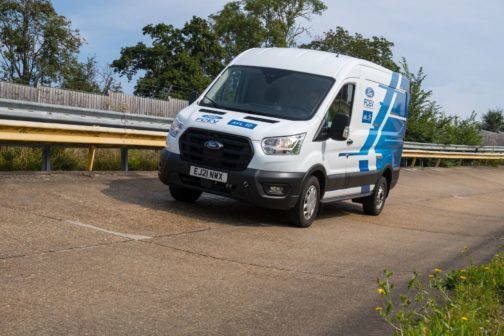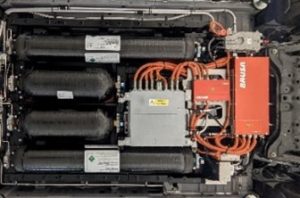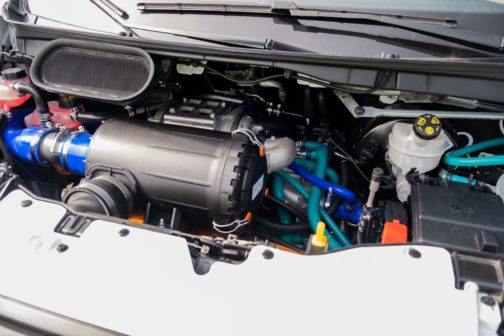Delivering the goods: prototype fuel cell electric Transit van
Developed in under 12 months through APC Advanced Route to Market Demonstrator Competition
Light commercial vehicles have been the fastest growing vehicle type on Britain’s roads in the past decade.
They are critical to many essential services and even during the pandemic-hit year of 2020, when the volume of traffic from cars fell by 25% compared to the previous year, the rise of the van was only briefly halted.
This means that the growing number of miles driven by vans and small trucks with internal combustion engines has a negative impact on air quality and greenhouse gas emissions.

APC CEO Ian Constance (right) with Bernadette Longridge (AVL, centre) and Dennis Witt (Ford, left) and the prototype FCEV Transit van, exhibited at the Low Carbon Vehicle Show 2021
The automotive industry is continually testing different solutions to tackle these issues – but in November 2020 impacts on the sector from COVID-19 threatened development of low-carbon technology. In a bid to prevent this, the Advanced Propulsion Centre (APC) supported £16.5 million of combined government and industry investment into a new Advanced Route to Market Demonstrator (ARMD) competition: a 12-month fast-start initiative to develop physical demonstrators of the technologies that will power the green industrial revolution.
It’s through one of these projects, known as FCVGen1.0, that Ford UK and AVL Powertrain UK partnered to deliver a demonstrator light commercial fuel cell electric vehicle. The targeted ARMD funding of £1 million from the APC provided support and a framework for the work to go ahead in the period of uncertainty created by the pandemic.
With a total value of £2.4 million, the project had two main aims:
- convert a regular battery-electric Ford Transit van to run with a hydrogen fuel cell
- create a digital version for simulated running in the virtual world.
The project, in less than twelve months, successfully built a physical prototype van as well as created a holistic vehicle simulation model – or digital twin – to optimise and capture all the features of the real-life version to work with a ‘digital toolkit’.
Watch this case study video, shared with permission of AVL and Ford, to find out what the benefits of APC ARMD funding were, and the outcomes achieved by the project – as told by the people working on it.
During the course of the project a theory was tested and then proved to be correct: that hydrogen and fuel cell propulsion can offer a feasible technology alternative to achieve zero-emission tailpipe solutions in the light commercial vehicle sector.
Specifically, the technology helps to solve a worry for van users and operators, that at the end of the day, their vehicles can maximise time on the road and number of journeys, without lengthy recharging or refuelling times.
Showing that the experience and convenience of quick refuelling can be replicated by a zero-emission vehicle, safely powered by hydrogen, was one of the main incentives for initiating the work.
Speaking about the project ahead of showcasing the vehicle at LCV2021, Simon Palmer, Chief Engineer, at Ford of Europe, said:
“Ford Motor Company and AVL Powertrain UK were thrilled to partner in the APC-funded project named FCVGen1.0.
“Using Ford’s expertise in commercial vehicles coupled with AVL’s system integration know-how, this project explored the potential for hydrogen fuel cell-based light commercial vehicles that can deliver high-load carrying and unbeatable uptime performance – with zero exhaust emissions.
“The cross-partner project team worked seamlessly together to successfully deliver a functional demonstrator fuel cell vehicle, the first of its kind in Ford of Europe, along with its digital twin. The ARMD competition offered a suitable platform that enabled the project to achieve all its goals, by offering funds, and by facilitating a collaborative framework, with project management support.”
Hydrogen tanks neatly packaged underfloor along with the DC/DC units (centre). The fuel cell stack and accessories at the front the vehicle (right). Photos courtesy of Ford and AVL.
The fuel cell vehicle was developed in AVL’s Engineering Centre based at a facility in Basildon, and the learning gained is being felt far wider than this project alone as Dr. Bernadette Longridge, Engineering Centre Manager, AVL Powertrain UK, explains:
“Within our vehicle centre we’ve also increased our capabilities to not only build fuel cell stack system assemblies, but also integrate those into fully functioning vehicles and commission those vehicles ready for use on the track.
“The knowledge and consolidation of our expertise on this fuel cell R&D project has allowed us now to support both global AVL fuel cell projects, but also lead fuel cell projects from the UK to support our UK market and UK customers.”
Read this report from AVL’s website for further technical details of the work packages delivered by FCVGen1.0 , such as the hydrogen storage system and refuelling systems.


